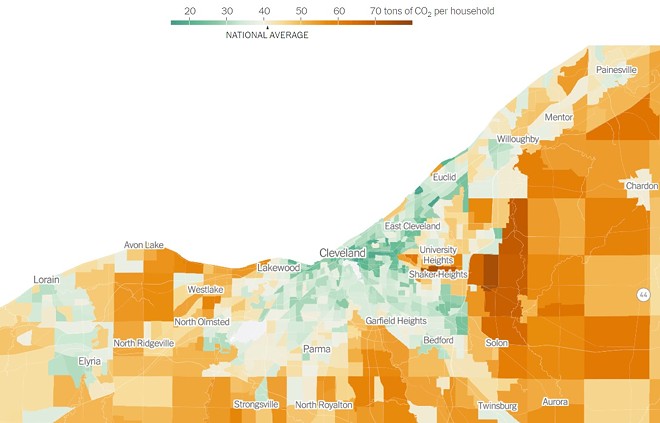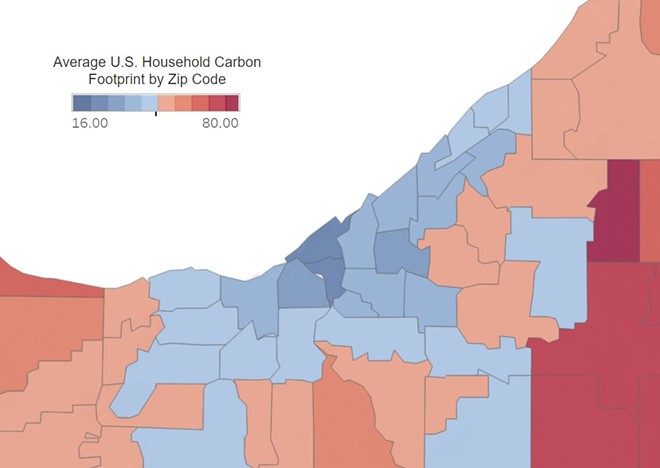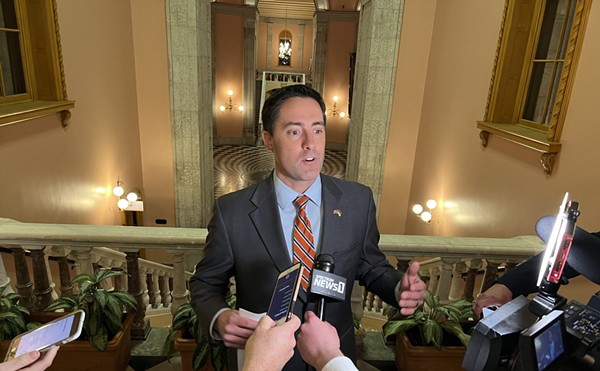Handy Map Shows In Cleveland, as Elsewhere, Suburbs and Exurbs are Driving Carbon Emissions
Bigger houses, longer commutes and sprawl are, it turns out, bad for the environment
By Maria Elena Scott on Fri, Dec 16, 2022 at 12:59 pm
[
{
"name": "Ad - NativeInline - Injected",
"component": "38482495",
"insertPoint": "3",
"requiredCountToDisplay": "5"
},{
"name": "Real 1 Player (r2) - Inline",
"component": "38482494",
"insertPoint": "2/3",
"requiredCountToDisplay": "9"
}
]
Two-thirds of Cuyahoga County residents are worried about climate change and nearly half believe it will affect them personally, according to a recent study conducted by the Yale Program on Climate Change Communication.
These residents should see how drastically carbon emissions differ by area.
Using data from CoolClimate, the New York Times this week mapped carbon emissions by neighborhood across the country. The maps show, unsurprisingly, that the suburbs and exurbs produce far more greenhouse gas emissions than dense cities.
Because residences, businesses and services in cities are geographically closer, residents tend to drive less in their daily lives. As such, dense cities generate less carbon emissions than sprawling suburbs, where residents log long commutes to work and anywhere else. City dwellings are also usually smaller than their suburban counterparts, which means they require less energy for heating and cooling. Outside of cities, this trend reverses.
Density and wealth are the two biggest determinants, which is why there's such a dramatic difference between, as an example, 44040 (Gates Mills), which has the highest average household carbon footprint in the county at 85.6 tons, and 44115, which has an average household carbon footprint of 16.5 tons.
Travel, by either car or airplane, is a big contributor to emissions—as is shopping. Because both travel and shopping typically increase with income, richer people usually produce more greenhouse gasses.
But while measures like avoiding fast fashion and limiting meat consumption can help reduce emissions, they are drops in the bucket compared to the biggest thing Americans can focus on.
“Anyone who cares about climate policy really needs to pay a lot more attention to housing,” said RMI Urban Transformation program senior associate Zack Subin.
Amid a national housing shortage, affordability and availability are often easier to find in communities with higher emissions. Building population-dense, multifamily dwellings, especially with close access to public transit, is one way to effectively lower community emissions.
Coming soon: Cleveland Scene Daily newsletter. We’ll send you a handful of interesting Cleveland stories every morning. Subscribe now to not miss a thing.
Follow us: Google News | NewsBreak | Instagram | Facebook | Twitter
Tags:
SCENE Supporters make it possible to tell the Cleveland stories you won’t find elsewhere.
Become a supporter today.
Scroll to read more Cleveland News articles
Newsletters
Join Cleveland Scene Newsletters
Subscribe now to get the latest news delivered right to your inbox.













